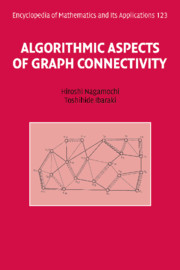Refine listing
Actions for selected content:
1413 results in Ebooks in network science
Appendix B - Modelling the local structure of networks
-
-
- Book:
- Networks in Cell Biology
- Published online:
- 05 June 2012
- Print publication:
- 13 May 2010, pp 188-209
-
- Chapter
- Export citation
8 - Signalling networks
-
-
- Book:
- Networks in Cell Biology
- Published online:
- 05 June 2012
- Print publication:
- 13 May 2010, pp 135-169
-
- Chapter
- Export citation

Algorithmic Aspects of Graph Connectivity
-
- Published online:
- 07 May 2010
- Print publication:
- 08 September 2008
1 - The Structure and Functions of Networks
-
- Book:
- Networks in Telecommunications
- Published online:
- 05 June 2012
- Print publication:
- 08 June 2009, pp 13-38
-
- Chapter
- Export citation
PART III - POLICY APPLICATIONS
-
- Book:
- Networks in Telecommunications
- Published online:
- 05 June 2012
- Print publication:
- 08 June 2009, pp 231-232
-
- Chapter
- Export citation
3 - Pricing Network Services
-
- Book:
- Networks in Telecommunications
- Published online:
- 05 June 2012
- Print publication:
- 08 June 2009, pp 77-116
-
- Chapter
- Export citation
Frontmatter
-
- Book:
- Networks in Telecommunications
- Published online:
- 05 June 2012
- Print publication:
- 08 June 2009, pp i-vi
-
- Chapter
- Export citation
10 - The Regulation of Last-Mile Broadband Networks
-
- Book:
- Networks in Telecommunications
- Published online:
- 05 June 2012
- Print publication:
- 08 June 2009, pp 334-372
-
- Chapter
- Export citation
7 - Constitutional Limits on the Pricing of Access to Networks
-
- Book:
- Networks in Telecommunications
- Published online:
- 05 June 2012
- Print publication:
- 08 June 2009, pp 210-230
-
- Chapter
- Export citation
9 - Antitrust as Applied to Network Industries
-
- Book:
- Networks in Telecommunications
- Published online:
- 05 June 2012
- Print publication:
- 08 June 2009, pp 282-333
-
- Chapter
- Export citation
5 - Economic Effects of Regulating Access to Networks
-
- Book:
- Networks in Telecommunications
- Published online:
- 05 June 2012
- Print publication:
- 08 June 2009, pp 152-189
-
- Chapter
- Export citation
4 - Network Regulation Basics
-
- Book:
- Networks in Telecommunications
- Published online:
- 05 June 2012
- Print publication:
- 08 June 2009, pp 119-151
-
- Chapter
- Export citation
Preface
-
- Book:
- Networks in Telecommunications
- Published online:
- 05 June 2012
- Print publication:
- 08 June 2009, pp xiii-xiv
-
- Chapter
- Export citation
11 - The Regulation of Broadband Networks and the Internet: Network Neutrality versus Network Diversity
-
- Book:
- Networks in Telecommunications
- Published online:
- 05 June 2012
- Print publication:
- 08 June 2009, pp 373-404
-
- Chapter
- Export citation
Contents
-
- Book:
- Networks in Telecommunications
- Published online:
- 05 June 2012
- Print publication:
- 08 June 2009, pp vii-xii
-
- Chapter
- Export citation
8 - The Regulation of Local Telephone Networks
-
- Book:
- Networks in Telecommunications
- Published online:
- 05 June 2012
- Print publication:
- 08 June 2009, pp 233-281
-
- Chapter
- Export citation
6 - Pricing of Access to Networks
-
- Book:
- Networks in Telecommunications
- Published online:
- 05 June 2012
- Print publication:
- 08 June 2009, pp 190-209
-
- Chapter
- Export citation
Table of Cases
-
- Book:
- Networks in Telecommunications
- Published online:
- 05 June 2012
- Print publication:
- 08 June 2009, pp 487-493
-
- Chapter
- Export citation
Bibliography
-
- Book:
- Networks in Telecommunications
- Published online:
- 05 June 2012
- Print publication:
- 08 June 2009, pp 439-472
-
- Chapter
- Export citation
12 - The Regulation of Broadband Networks and the Internet: Network Neutrality versus Network Capacity
-
- Book:
- Networks in Telecommunications
- Published online:
- 05 June 2012
- Print publication:
- 08 June 2009, pp 405-432
-
- Chapter
- Export citation
